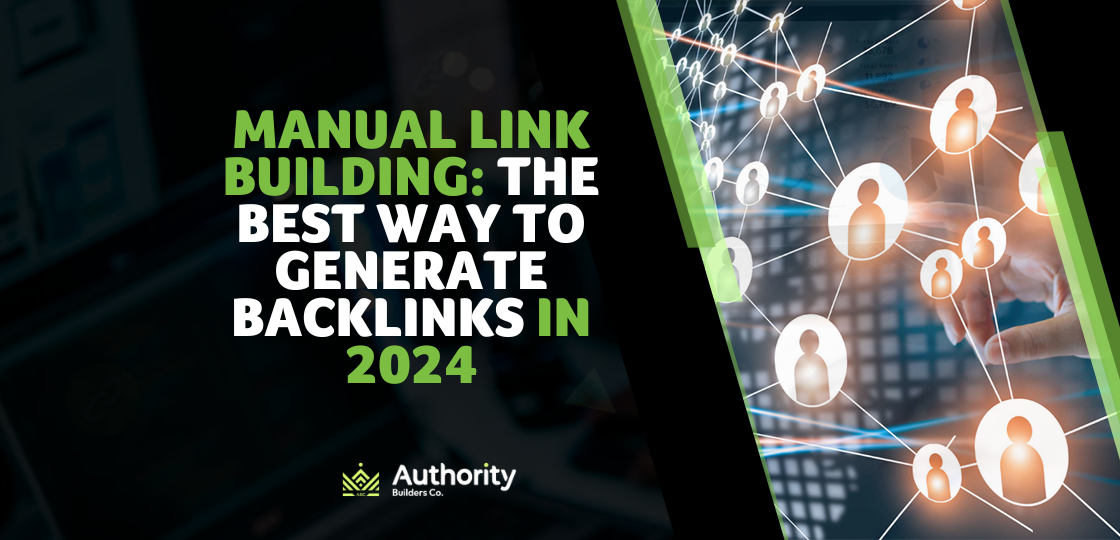
Automation is great for many things. It can handle repetitive tasks, make complex calculations, and speed up admin processes.
Because of this, many people have started using it to support their link-building efforts.
The problem is that AI isn’t so good for building high-quality backlinks.
Why?
Because high-authority websites want to build genuine relationships and link to high-quality content—and AI and automation aren’t capable of achieving this well enough yet.
That’s where manual link building comes in, which is when most of the link-building process is done by real people.
Overall, it results in more opportunities for better backlinks, leading to higher rankings in search engines.
This article explains what manual link building is, why it’s effective, and lists eight manual link-building techniques you can use.
Contents:
What Are the Hallmarks of Manual Link Building?
8 Manual Link-Building Strategies
Build Manual Links with Authority Builders
What Is Manual Link Building?
Manual link building is when you get other websites to post backlinks to your website instead of relying on software to do it for you.
The idea behind manual link building is that there are some things that people do better than computers.
Namely:
✔️ Identifying relevant, targeted linking opportunities.
✔️ Building genuine relationships with website owners and industry influencers by sending personalized outreach emails.
✔️ Writing high-quality content that readers find valuable.
What is automated link building?
Automated link building is when you use software to do all of the above.
This results in:
⚠️ Targeting link-building campaigns at less relevant websites.
⚠️ Generic email campaigns.
⚠️ Unoriginal content with little depth and insight.
Why is manual link building effective?
Manual link building generally results in higher-quality, more natural backlinks than automated link building.
The quality of content and its relevance are two of the factors that search engines use to judge the quality of backlinks.
Automated link-building campaigns, on the other hand, are more about building a large number of links fast.
As a result, automated links tend to be accepted by websites with lower editorial standards. These sites usually charge for links and are more interested in making a quick buck. As a result, the backlinks you build with them are often low-quality.
Furthermore, the sites you build manual links to are more likely to build new links to your site for free and keep them active for longer. This is because you have taken the time to build a genuine relationship with them.
Manual link-building can be time-intensive; for those considering outsourcing, knowing the link-building pricing helps set realistic expectations.
💡In summary: Manual link building generally results in a smaller number of high-quality links, while automated link building can result in a large number of lower-quality links.
The risks of automated link building
One of the biggest problems with automated link building is that you have less control.
You might decide that you’re happy to trade off some quality and relevance in exchange for building links faster.
The problem is you won’t necessarily know which sites you are building links to because you are handing decision-making over to software.
You could end up inadvertently building links to link farms or other dodgy sites.
| 💡 What is a link farm? |
| A link farm is a website that exists purely to make money from selling links.
They rarely offer any value to readers, the quality of their content is normally very low, and they cover broad and vague topics like “business” or “technology.” |
Search engines like Google penalize websites that try to manipulate search results. This could involve:
- Ignoring your backlinks
- Reducing your rankings
- De-indexing your site
If it sees that you have built a large number of links unusually quickly and those links are from dodgy websites, Google will realize what you are up to.
What Are the Hallmarks of Manual Link Building?
Let’s explore some of the factors that make manual link building a source of high-quality backlinks:
✅ Targeted
Automated link building tends to take a “spray and pray” approach to link building. In other
words, you target as many websites as possible and see how many links you get.
The problem with this approach is that you are less likely to get relevant links. Relevance is one of the most important Google ranking factors—this was confirmed in the recent leak of Google documents relating to its search algorithm.
With manual link building, you choose which websites you intend to reach out to. This means you can target relevant, influential, high-quality websites in your industry that will have a positive impact on your brand and search rankings.
✅ Build relationships
Website owners are often inundated with link-building requests. This is especially true if the site is reputable or high quality.
Send a busy site owner an automated message asking for a link and they will probably ignore it.
Manual outreach, on the other hand, involves building genuine relationships with website owners.
By writing an outreach email that is uniquely aimed at them, you show that you are genuinely interested in providing value to their website.
This makes it more likely that they will respond positively.
Manual outreach isn’t just about getting a backlink. It’s about understanding the target website’s audience, the kind of content they want to link to, and how you can work together for mutually beneficial results.
✅ Valuable content
Automated link building often involves using AI platforms like ChatGPT or Jasper to quickly create content.
Content from these platforms is often well-structured and free from grammatical and spelling errors.
However, these platforms glean their knowledge from what’s already published online. This means that what they produce is never original.
Also, its content is sometimes inaccurate—AI cannot tell whether something isn’t true and it gathers unverified or incorrect content to fill in gaps without you being able to tell the difference between fact and fiction.
By writing content yourself or using a professional writer, you can ensure that your content is accurate, original, and comprehensively answers the reader’s question.
| 🤔 So I should always avoid using AI and automation?
No! AI and automation tools are incredibly powerful.
But humans should ultimately be in control when making important strategic decisions or creating something that needs to connect with other people.
For example, when we produce content we use AI and automation to tell us what keywords to include.
AI could add those keywords to the content for us—but it doesn’t always understand what reads well and sometimes gets its facts wrong.
So our writers produce the content and add the AI-identified keywords themselves. Our writers’ work is made better and more efficient by automation. |
8 Manual Link-Building Strategies
Now that you know why manual link building is so important, let’s explore how you can go about it. Here are eight manual link-building strategies.
Linkable assets
This is when you create content that is so valuable to your audience that they naturally want to share it.
You don’t reach out to website owners and ask them to link to it. Instead, you simply publicize the resource to your audience via social media and your blog.
By “content” we don’t just mean written content. We’re talking:
- Images
- Videos
- Audio
- Tools
- And more
It covers any resource they can engage with and share online. For example, Cycling News has a page dedicated to the Tour De France.

The page is updated regularly throughout the event. It covers things like:
🚲 The latest news from the race
🚲 Key facts about the race
🚲 The current standings
🚲 In-depth reporting on each stage
🚲 An overview of how the competition works
🚲 Which riders to watch out for
🚲 Who the teams are
This critical resource for Tour De France enthusiasts has generated over 64,000 backlinks from 1,500 referring domains.
Local citations
This is when your business’s name, address, and phone number (NAP) are published and verified by online directories or similar sites.
They are critical for local SEO, as they help search engines locate your business. This means that when someone performs a location-based search, the search engine knows which sites to show.
The important word here is “verified”. Anyone selling bikes can target keywords like “bicycle shop San Francisco”. However, search engines want to prioritize businesses they know are based there because it better fulfils the search query.
By verifying your location through local citations, you prove your location to Google.
Local citations also help fulfil the “trust” part of Google’s Expertise, Experience, Authority, Trust (EEAT) requirements.
By verifying NAP data, you prove that you are a real business with a real physical location.
Local citations are some of the easiest manual links you can build. You simply set up a profile and enter your NAP data into an online directory.
Some of the best directories to target include:
Google Business Profile: Getting your business featured in the directory associated with the world’s most popular search engine is a no-brainer. Google says that starting a Google Business Profile helps improve your local SEO.

Yelp: Local directory Yelp gets over 183 million monthly visitors. It’s free to list your business in its directory. However, you can also get paid packages that offer greater visibility in its search.

Bing Places for Business: Bing gets more than 7% of US search volume and more than 10% of global desktop search. This isn’t anywhere near as much as Google, but it’s still worth having a presence on it.
Facebook business page: Facebook has over 3 billion monthly users. It’s owned by Meta that also owns Instagram (2 billion monthly active user accounts). Once your business has been listed on one of these two platforms, it’s easy to set it up on the other.

Apple Business Connect: Apple doesn’t have its own search engine but it does have services with search functionality, Apple Maps being a good example of this. While it only has 29 million users (compared to Google Maps’ 1.8 billion), it’s still worth being listed on. To do this, you need to sign up for Apple Business Connect.

Guest blogging
This is a popular manual link-building technique. It involves writing articles that are published on someone else’s blog.
A good manual guest blogging campaign covers all three elements mentioned earlier. To remind you, they are:
✅ Targeted: Aim to publish your content on high-authority websites that are relevant to what you do and get decent organic traffic.
✅ Genuine outreach: Send the website owner a personalized message and explain why your idea would work well for their audience.
✅ High-quality content: Create professionally-written content that is well-researched and provides value to readers. This will:
- Stand more chance of being approved by the site owner.
- Generate organic traffic.
- Improve your brand reputation.
- Increase the chances that you’ll be asked to contribute in the future.
Guest post content needs to be well-written and perfect for the website’s technical audience.
Another white-hat tactic is link insertion outreach, where you contact site owners to insert your link into existing relevant content, securing a contextual backlink.

Digital PR
Digital PR covers a range of applications, including:
📣 Brand building.
📣 Reputation management.
📣 Building relationships with journalists and publications.
The last point is most relevant to building manual links. The aim of digital PR in manual link building is to get your brand or business covered by the media.
This could be through:
💡 Providing expert commentary on current affairs.
💡 Hosting fun or interesting events.
💡 Publicity stunts.
💡 Publishing useful or insightful research.
💡 Press releases.
Digital PR backlinks are some of the most powerful ones out there. That’s because media publications often have very high site authority. This means search engines trust them, so they give a greater ranking benefit to the pages they link to.
They’re also often relevant and natural. Journalists typically link to something when it supports what they are writing about—not because they are being paid to.
The challenge with digital PR, and the reason it takes a lot of manual effort, is that journalists won’t just quote or link out to anyone.
They care about their editorial integrity. They will only give you coverage if they think your content will be valuable for their readers.
Even if your PR campaign adds value, it could be that it’s a busy news day, which means more important stories will get prioritized over yours.
Many businesses outsource digital PR because creating campaigns and building relationships with journalists is such hard work.
Connectively (formerly HARO)
One of the hardest parts of building digital PR links is finding opportunities to be quoted by journalists.
It’s much better if the opportunities come to you. If you’ve formed strong relationships with industry journalists, then this could happen.
But if you haven’t, then a platform like Connectively might be helpful because it’s a website that connects journalists with experts.
Previously known as HARO, Connectively allows journalists to post questions; the answers they get then help them write their articles. Experts can explore the list of questions and look for one that they can answer.
If a journalist likes your answer, then they will quote you and likely include a link to your website. This is one of the easiest ways to manually build high-quality backlinks.
The downside is that Connectively is a popular platform and journalists are often inundated with responses. In our experience, you can expect a one-in-ten hit rate.
Influencer marketing
Influencer marketing is when a well-known person in your industry promotes your brand.
It’s a good way to build manual links because it involves building relationships with the person.
Many influencers make an income from advertising products. If you simply ask them to mention your business or link to it, then they will probably ask for money.
To get mentioned naturally (and for free), you need to offer them value. This could include:
- Sending them a free sample of your product
- Offering them a free trial of your service
- Inviting them to your podcast or YouTube show
- Interviewing them for a blog post
- Showing them something useful or telling them something they didn’t know
Here’s a good example from Andertons’ YouTube channel. Andertons is a chain of guitar shops that also has a popular e-commerce website.
They invited well-known online guitar teacher Justin Sandercoe onto their YouTube show to tell them what he would choose for his guitar setup.
For Sandercoe, this is a chance to publicize his own online guitar lessons to Andertons’ audience (and try out some cool guitar kit).
It’s likely that he’ll tell his followers about the show on social media and mention it on his blog. This will result in backlinks from Sandercoe and his audience.
Broken link building
This is when you look for backlinks that no longer work and “fix” them by suggesting that the website owner links to your content instead.
There are many reasons that a backlink could break, including:
- Incorrectly formatted URL
- The website structure or URLs have changed
- The domain name has changed
- Malfunctioning plugins
- The target page has been moved or deleted
The best broken link building opportunities are presented by the last point. From the user’s perspective, these usually appear as a 404 error stating that the page could not be found.
Here’s a fun example from Marvel.com.
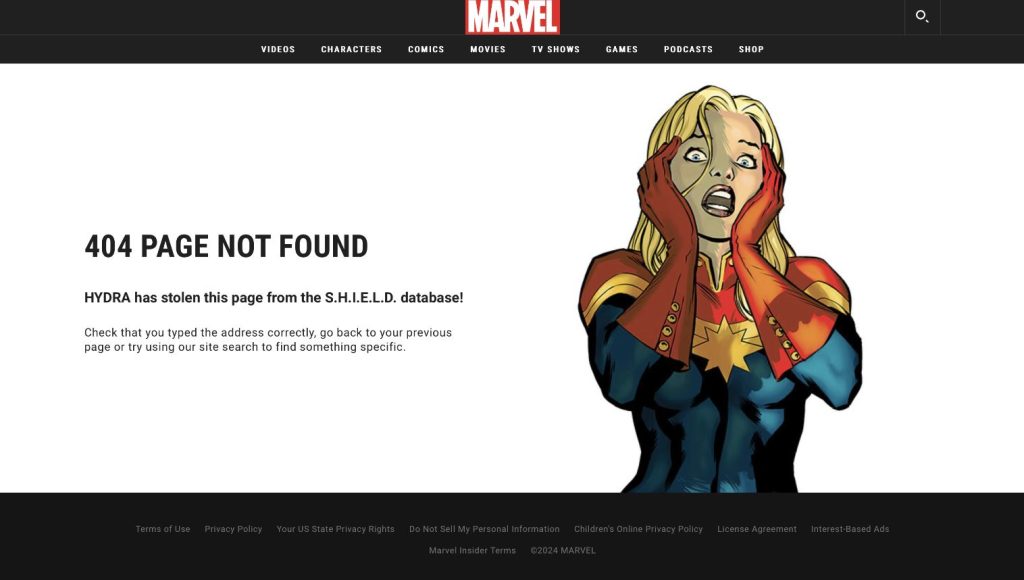
The reason these broken links make good broken link building opportunities is because the content that has been moved or removed can be replaced by yours.
There are several ways to find broken link building opportunities. We usually use an SEO tool called Ahrefs.
There are several approaches you can take:
1. Find dead pages on competitor websites
Open Ahrefs’ Site Explorer, type a competitor’s domain into the search bar, and push enter.

Click “Best by links” in the sidebar.

Select “404 Not found” in the filter and click “Show results.”

Choose a broken page and click the drop-down labeled “Links to page.” This shows you which pages link or used to link to this broken page.
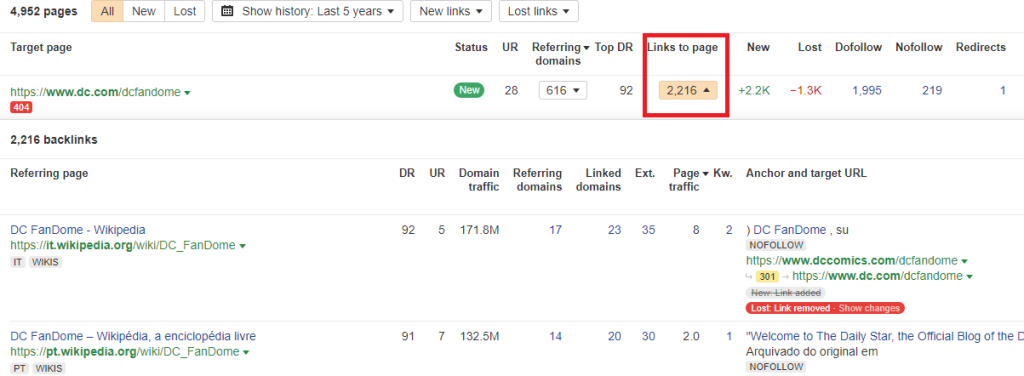
You could create your own version of this content and contact the website in question to suggest fixing the link by pointing to your new page instead.
Use Ahrefs’ Content Explorer
This approach allows you to search Ahrefs’ web page database for broken links based on a topic.
Here’s how to use it:
Click on “Content Explorer” and enter a topic into the search bar. Choose “In title” from the menu and hit enter.

Next, set the filter to show broken pages only.
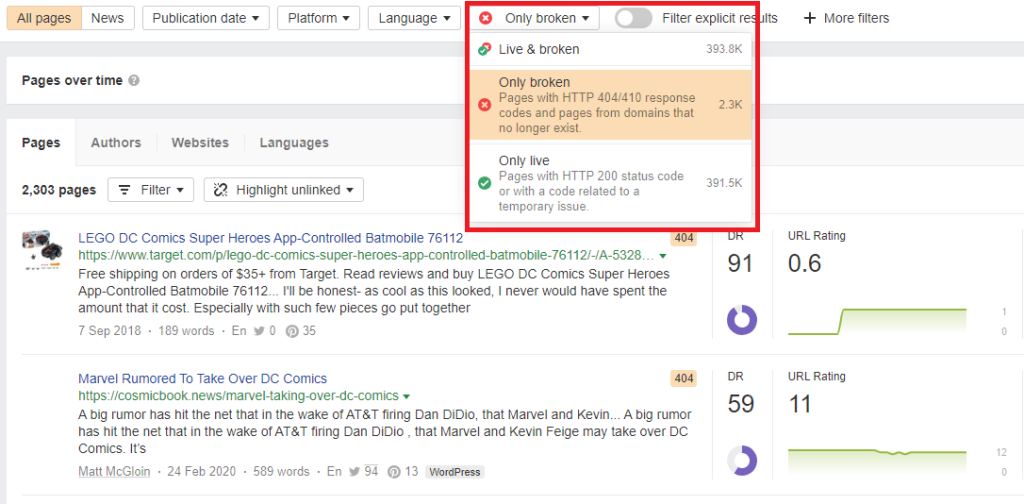
Filter for pages with at least 20 referring domains.

Ahrefs will show you a list of broken pages on your chosen subject with links pointing to them. The list is ordered by the number of broken links.
The top result below has 84 results pointing to it—that’s a lot of manual link-building opportunities!

Just to be sure, click on the link to verify the page is dead:

Skyscraper
The Skyscraper technique was devised by SEO expert Brian Dean. It involves looking at your competitors’ content and creating content that is 100x better.
The idea is that websites would want to link to your content if it stands head and shoulders above that of your competitors (like a skyscraper).
Here are three steps for a successful skyscraper manual link-building campaign.
1. Find popular, relevant content
The best place to start looking for Skyscraper opportunities is to look at your competitors’ websites and see what generates a lot of links for them.
You can do this using Ahrefs. Here’s how:
Open Site Explorer, type in one of your competitor’s websites and hit enter.

In the left sidebar, click on “Best by links.”

Order the page by the number of referring domains.

This will show your competitor’s most popular pages in terms of backlinks.
Do this for several competitors to get a feel for the kind of content that draws a large number of backlinks.
1. Create better content
Next, it’s time to produce that competitor-beating content. But what do we mean by better content? Put simply:
We mean that it’s:
🏙️ Better written.
🏙️ Longer.
🏙️ More up-to-date.
🏙️ Better researched.
🏙️ Better designed.
🏙️ Uses a wider range of media.
🏙️ More comprehensive.
🏙️ More in-depth.
You shouldn’t aim to create content that’s only slightly better than the strongest competitor’s content. Instead, aim to create something that is noticeably better.
This ensures that website owners will want to link to it.
1. Reach out
Next, you need to find out which websites are linked to the original competitor content that you have improved upon.
To do this, go back to your results in Site Explorer. Select “Dofollow” and click “Show results.”

Choose the target page on which your Skyscraper content is based and click the arrow in the “Links to page” column. This will show you all the pages that link to this page.
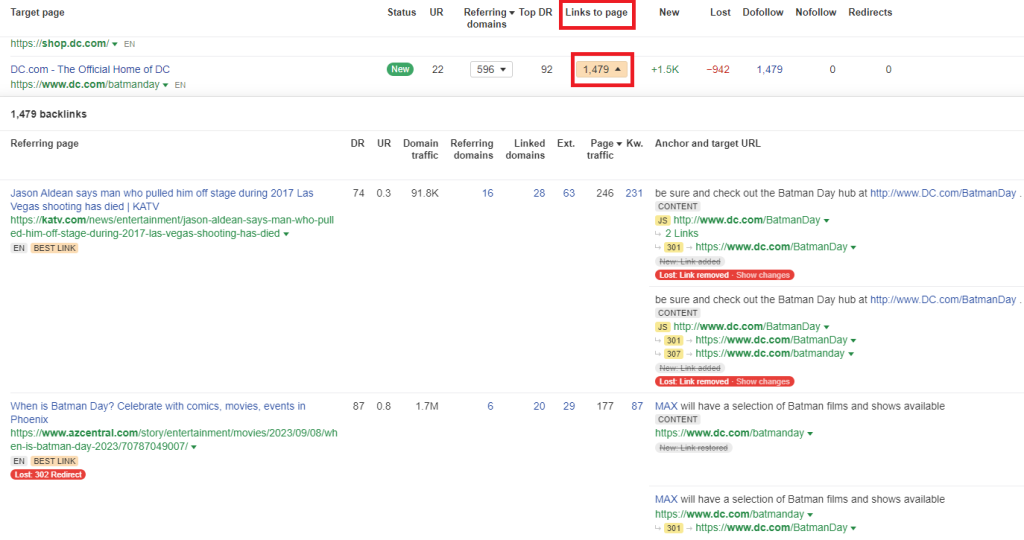
Click on each linking site and look for the website owner or content manager’s contact details.
Write an email that covers the following:
- Name the person and tell them why you like their website.
- Highlight the link you want to replace.
- Send them a link to your new content.
- Tell them why you are a good source to link to and highlight why your content is far better.
- A clear request for them to swap the existing link for yours.
A good example might be:
Hi Jo,
I love your Superhero fan site, especially your recent coverage of ComicCon on YouTube.
I recently saw that you have linked to DC’s page on its collectibles.
We’ve written our own version on Marvel’s collectibles—you can see it here.
Our page shows a much wider range of collectibles than DC’s. Plus, we’ve created short videos for each product AND included a detailed profile.
We think your readers will find it more useful than the DC page—especially given we’re the world’s number one comic brand.
Would you consider replacing the DC link with ours?
Look forward to hearing from you,
Stan
| 💡 Tip: Be patient and tenacious |
| You might not get a response from the website owners you contact at first. They are usually busy people and may miss your email or forget to respond.
It’s usually a good idea to send a polite reminder a few days later. If you still don’t get a reply, then move on to the next opportunity—you don’t want to become a nuisance. |
Build Manual Links with Authority Builders
Manual link building is the best way to ensure you get natural, high-quality backlinks.
Over time, you’ll build a strong backlink profile that will help you rank higher in the SERPs. Plus, you’ll build strong relationships with other experts in your industry.
But, as the name suggests, manual link building entails a lot of work. That’s why it’s often better to outsource it to a link-building agency like Authority Builders.
Since 2016, we’ve been helping clients increase organic traffic by building high-quality links. Work with us, and you’ll get:
✅ A fully customized link-building strategy
✅ 100% manual outreach
✅ High-quality content
Schedule a call to learn how we can take the hard work out of building manual links to your website.
